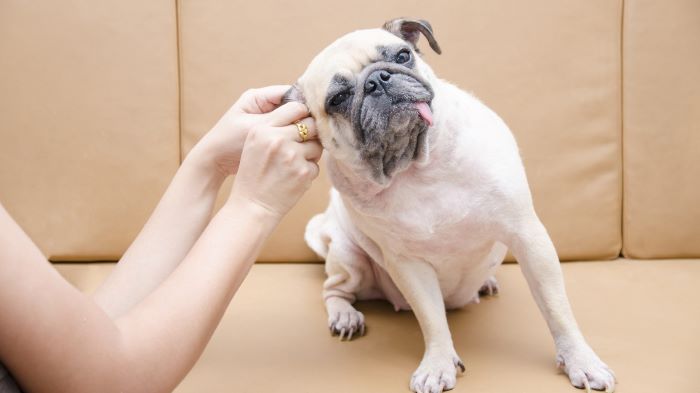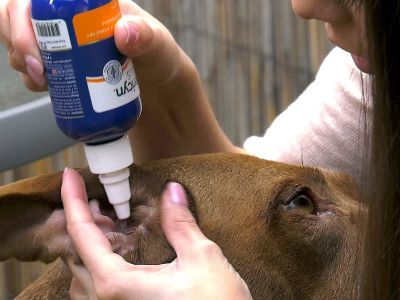We always want our dog to be happy and healthy. For this, along with nutritional diet, a regular grooming is also necessary. One of the aspects of dog care that is often neglected is ear cleaning. Dog ears are sensitive and prone to various problems, such as infections, parasites, yeast, allergies and injuries. Therefore, it is important to clean them regularly.

But have you wondered how to clean dog ears properly and safely as well as how often and when to do it. Let us explore some tips and guidelines on how to clean dog ears, as well as some common mistakes to avoid.
How often should I clean my dog’s ears?
How often to clean the ears of your dog depends on the breed as well as regular activities of your dog. Dog breeds with long ears, such as Basset Hounds and Cocker Spaniels, are at higher risk of ear infections and hence require regular ear cleaning. This is due to the fact that longer droopy ears enable less air flow and moisture can easily become trapped in the ear canal, resulting in a yeast infection.
Dogs who are fond of swimming will also require regular ear cleaning because the excess moisture can lead to ear infections.[1] Additionally, you should always check your dog for ear mites because they are a potential cause of ear infections. “The mites feed on your dog’s ear and skin surface debris, which causes inflammation and irritation. They are transmitted from one animal to another through physical contact.“, confirms Amanda Simonson at petMD.

Some dogs have naturally healthy, clean ears and may never require ear cleaning, however other dogs require frequent ear cleaning to prevent dirt accumulation that can lead to ear infections. If you notice a mild odour or see that your dog is shaking his head more than usual, it’s probably time for an ear cleaning.
Things You’ll Need
Your dog just needs a few supplies to safely clean the ears. A cotton ball or gauze, dog ear cleaning solution and a clean and dry towel. Never use cotton swabs with pointed tip designed for humans. These tools can force dirt and debris further into your dog’s ear canal, causing infections and possibly causing trauma to the ear’s inner components.
Thus, supplies for cleaning your dog’s ears are:
- cotton ball/gauze
- dog ear cleaning solution
- clean and dry towel
- Plenty of treats during and after the ear cleaning.
How to Clean a Dog’s Ears?
It is important to clean your dog’s ears regularly or when required. If not, it can lead to serious problem like ear infection that may cause harm and discomfort to your dog.[2] Thus, cleaning your dog’s ear is one of te most important gerooming habit.
Though ear cleaning process looks safe and clean, it can be messy sometimes. Your dog might shake his head while putting in the ear solution. Thus, it is a good idea to clean your dog’s ears in bathroom or some other room that can be cleaned easily.

Here are some steps to follow to clean your dog’s ears safely and effectively:
- Gather the supplies you need, such as a cotton ball or gauze, a dog ear-cleaning solution, and a clean, dry towel. Avoid using cotton-tipped swabs or anything with a pointed tip, as they can damage your dog’s ear canal.
- Gently fill up the ear canal with the cleaning solution. You can either squirt it directly from the bottle or soak a cotton ball and squeeze it into the ear. Make sure the solution is at room temperature as a cold liquid can be uncomfortable for your dog.
- Lightly massage the outside base of the ear to help break up the wax inside the ear canal. You should hear a squishing sound as the solution moves around. Do this for about 20 to 30 seconds per ear.
- Clean out excess moisture and wax gently with cotton balls or cloth. Wipe the part of the ear that you can easily see, the outer flap. Do not push too deep into the ear canal, as you may push the wax further in or cause injury. Use a fresh cotton ball for each ear.
- Reward your dog with praise and treats for being cooperative and patient. Repeat the process for the other ear if you haven’t done so already.
Don’ts of Cleaning Dog Ears
While cleaning your dog’s ears is one of the most crucial grooming habit, it is also important to accomplish it in a correct manner. You need to take care that you do not hurt the dog.
Hence, it is necessary to be aware of the following:
- Never use cotton swabs with pointed tips to clean the ears. It can push the dirt or wax deep inside the canal and can damage your dog’s ear canal.
- Never use the same cotton ball for both ears to clean them. Use a fresh cotton ball for each ear.
- Do not use products such as hydrogen peroxide, rubbing alcohol or vinegar to clean your dog’s ears. These can irritate the inside of your dog’s ear and lead to more damage.
- If you suspect your dog has an infection, you may be tempted to clean his ears. However, cleaning your dog’s ears while they are infected may cause more harm. Always see your veterinarian before cleaning your pet’s ears if you suspect an ear infection.
- Don’t push through if the dog shows stress signals or move away from you when you’re cleaning their ears. It’s likely that they’re in discomfort.
- Do not clean your dog’s ears when they are agitated or excited. This could make them resist or struggle and increase the risk of injury. You should clean your dog’s ears when they are relaxed and calm in a confined space, such as the bathtub.
- Do not over-clean your dog’s ears. This could remove the natural protective layer of wax and make them more prone to infections. You should only clean your dog’s ears when you notice a change in their appearance or smell, or when recommended by your veterinarian.
As a paw parent, it is crucial to check your dog regularly for any signs or symptoms or a change in behaviour. With ear infection, you should regularly check their ears for any change as with some case it may lead to ear infection, which if not treated properly may cause other fatal diseases.
According to Malcolm Weir and Ernest Ward at VCA hospitals, “Dogs with ear infections are uncomfortable. They frequently scratch them and shake their head. This can cause an aural hematoma, in which blood vessels in the ear flap break, causing a painful swelling that requires surgical treatment. Deep ear infections can damage or rupture the eardrum, causing an internal ear infection and even permanent hearing loss.“
FAQs
How do I clean my dog’s ears?
The best way to clean dog ears is by following the above mentioned instructions. However, if you’re unable to or are apprehensive about accidentally hurting your dog, you can reach out to your professional groomers to help clean your dog’s ears for you.
What can I clean my dog’s ears with?
To clean your dog’s ears, simply use a dog ear cleaning solution. Because these bottles are designed specifically for dog ears, you are unlikely to cause eardrum harm. Remember not to use cotton buds because there is a risk of their getting too far into the ear and causing harm within the ear. Any home cures including human goods should be avoided because they can be harmful to your dog’s ears.
What are the symptoms for dog ear infection?
Some symptoms of a dog ear infection include itching, scratching, head-tilts towards the infected ear, unusual odour or discharge and red, painful ears. If you notice any of these symptoms, contact your vet immediately.
Overview
Cleaning your dog’s ears is not a difficult task, but it requires some knowledge and caution. You should always check your dog’s ears regularly for any signs of trouble such as redness, swelling, discharge, odour or pain. If you notice any of these symptoms, you should consult your veterinarian before attempting to clean your dog’s ears.
You should also use the right tools and products for ear cleaning, such as a soft cloth and a gentle ear cleaner. You should avoid using cotton-tipped swabs, hydrogen peroxide, rubbing alcohol, vinegar or any other harsh or pointed objects that could harm your dog’s ears. By following these simple steps, you can help your dog maintain healthy and clean ears.
References:
- O’Neill, D. G., Volk, A., Soares, T., Church, D., Brodbelt, D. C., & Pegram, C. (2021). Frequency and predisposing factors for canine otitis externa in the UK – a primary veterinary care epidemiological view. Canine Medicine and Genetics.
- Ear care for pets | VMBS News. (2022, March 11). VMBS.



